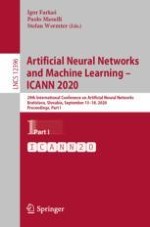2020 | Buch
Artificial Neural Networks and Machine Learning – ICANN 2020
29th International Conference on Artificial Neural Networks, Bratislava, Slovakia, September 15–18, 2020, Proceedings, Part I
herausgegeben von: Prof. Igor Farkaš, Paolo Masulli, Stefan Wermter
Verlag: Springer International Publishing
Buchreihe : Lecture Notes in Computer Science
